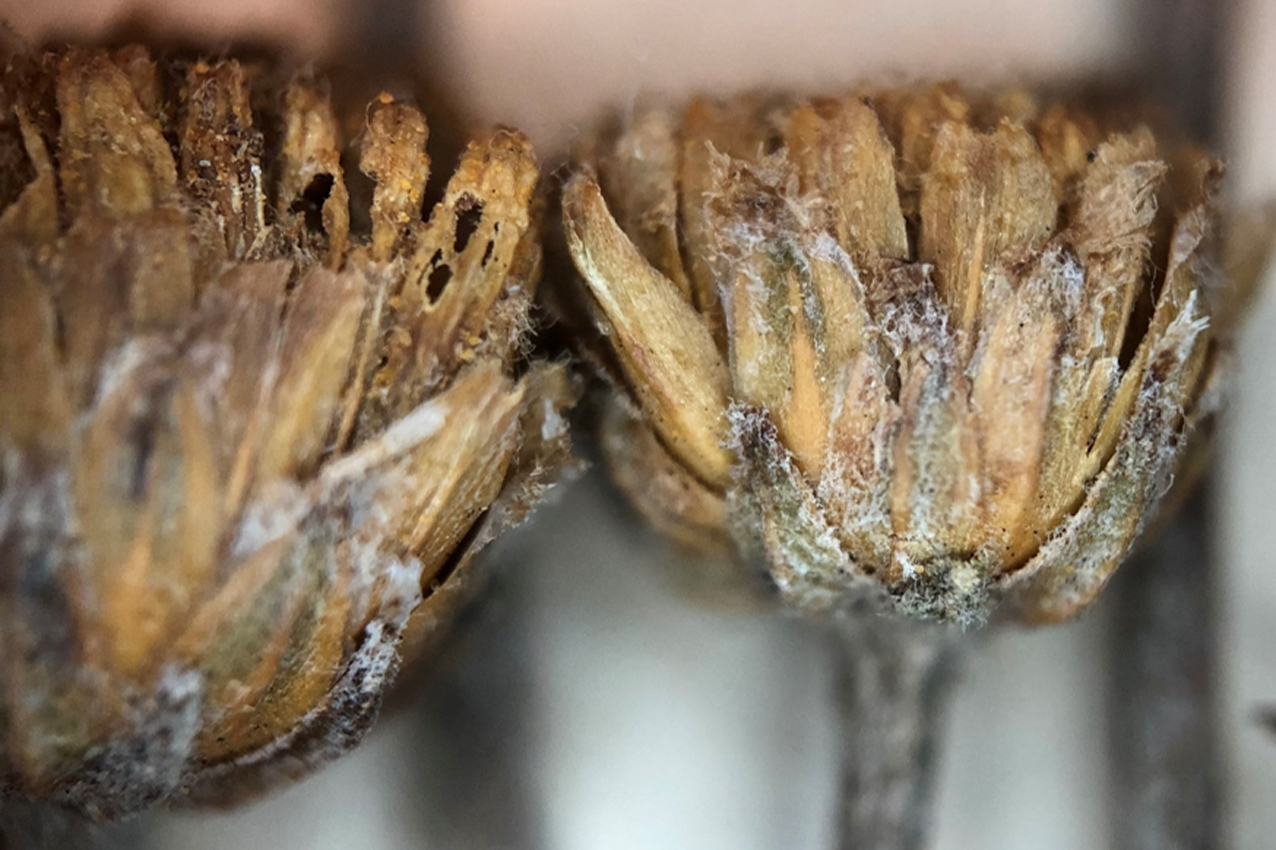Abstract
The typification of the species names Santolina ericoides and S. villosa (Asteraceae) are revisited. The name Santolina ericoides has been applied to plants distributed in the Iberian Peninsula and S France, and the name S. villosa has been applied to a taxon endemic to Spain. These species names have recently been neotypified from specimens kept at the herbarium of the Muséum national d’Histoire naturelle de Paris at P, and at the herbarium PAL (PAL-Gr), respectively. These two type designations are briefly discussed and superseded here because these neotypifications were unnecessary being contrary to Art. 9.8 of the International Code of Nomenclature for algae, fungi, and plants (Shenzhen Code). In this work, all relevant sources, specimens, illustrations, and references cited in the protologues are carefully evaluated for the purpose to fix the application of the names. We have chosen and designated the best admissible lectotype for these two names from the original material.
References
Bolós, O. de & Vigo, J. (1987) Notes sobre taxonomía i nomenclatura de plantes. Collectanea Botanica (Barcelona) 17 (1): 89–93. https://doi.org/10.3989/collectbot.1988.v17.159
Briquet, J. (1916) Études carpologiques sur les genres de composées Anthemis, Ormenis et Santolina. Annuaire du Conservatoire et du Jardin Botaniques de Geneve 18–19: 257–313.
Brittem, J. (1913) Philip Miller’s plants. Journal of Botany, British and Foreign 51: 132–135. https://www.biodiversitylibrary.org/page/8964640
Candolle, A.P. de (1837) Prodromus systematis naturalis regni vegetabilis, vol. 6. Treuttel et Würtz, Paris, 687 pp. https://doi.org/10.5962/bhl.title.286
Carbajal, R., Ortiz, S. & Sáez, L. (2019) Santolina L. In: Castroviejo, S., Benedí, C., Buira, A., Rico, E., Crespo, M.B., Quintanar, A. & Aedo, C. (Eds.) Flora iberica, vol. 16 (3). Real Jardín Botánico de Madrid, CSIC, Madrid, pp. 1938–1962.
Daléchamps, J. (1586) Historia generalis plantarvm, [Pars prima]. Apud Gvlielmvm Rovillivm, Lugduni, 1095 pp. [https://archive.org/details/bub_gb__NGRilRpGGIC/page/n949/mode/2up]
Dodoens, R. (1583) Stirpium historiae pemptades sex. Sive libri XXX. Ex officina Christophori Plantini, Antuerpiae, 860 pp. https://doi.org/10.5962/bhl.title.855
Giacò, A., Astuti, G. & Peruzzi, L. (2021) Typification and nomenclature of the names in the Santolina chamaecyparissus species complex (Asteraceae). Taxon 70 (1): 189–201. https://doi.org/10.1002/tax.12429
Greuter, W. (2008) Santolina L. In: Greuter, W. & von Raab-Straube, E. (Eds.) Med-Checklist. A critical inventory of vascular plants of the circum-mediterranean countries. II. Dycotyledones (Compositae) Genève: Organization for the Phyto-Taxonomic Investigation of the Mediterranean Area (OPTIMA), pp. 696–698.
Guinea, E. (1970) Santolinae europaeae. Anales de Instituto Botánico A. J. Cavanilles 27: 29–44.
Guinea, E. & Tutin, T.G. (1976) Santolina L.. In: Tutin, T.G., Heywood, V.H., Burges, N.A., Moore, D.M., Valentine, D.H., Walter, S.M. & Webb, D.A. (Eds.) Flora Europea, vol. 4. Cambridge University Press, Cambridge, pp. 144–145.
Jordan, A. & Fourreau, J. (1869) (“1869–1903”). Icones ad floram Europae novo fundamento instaurandam spectantes, vol. 2. Apud F. Savy, Paris, 52 pp. https://gallica.bnf.fr/ark:/12148/bpt6k96713046/f170.planchecontact
Linnaeus, C. (1753) Species plantarum, vol. 2. Impensis Laurentii Salvii, Holmiae [Stockholm], 1200 pp. https://doi.org/10.5962/bhl.title.669
López Udías, S., Fabregat, C. & Mateo, G. (1997) Santolina ageratifolia Barnades ex Asso (Compositae) y el agregado S. rosmarinifolia L. Anales del Jardín Botánico de Madrid 55: 285–296. https://doi.org/10.3989/ajbm.1997.v55.i2.275
Miller, P. (1731) The Gardeners Dictionary, 1st ed. Printed for the autor, London.
Miller, P. (1756-59) The Gardeners Dictionary, 7th ed. Printed for the autor, London. [https://gallica.bnf.fr/ark:/12148/bpt6k96668j]
Miller, P. (1768) The Gardeners Dictionary, 8th ed. Printed for the author, London. https://doi.org/10.5962/bhl.title.541
Morison, R. (1699) Plantarum historiae universalis Oxoniensis, vol. 3. E Theatro Sheldoniano, Oxonii [Oxford], 657 pp. + Tab. 1–22. [http://bibdigital.rjb.csic. es/spa/Libro.php?Libro=5556]
Poiret, J.-L.M. (1805) Santolina L. In: Lamarck, J.-B., Encyclopédie méthodique: Botanique, vol. 6. Chez H. Agasse, Paris, pp. 503–508. https://doi.org/10.5962/bhl.title.824
Rivero-Guerra, A.O. (2008a) Phenotypic differentiation of peripheral populations of Santolina rosmarinifolia (Asteraceae). Botanical Journal of Linnean Society 158: 650–668. https://doi.org/10.1111/j.1095-8339.2008.00902.x
Rivero-Guerra, A.O. (2008b) Cytogenetics, geographical distribution, and pollen fertility of diploid and tetraploid cytotypes of Santolina pectinata Lag. (Asteraceae: Anthemideae). Botanical Journal of Linnean Society 156: 657–667. https://doi.org/10.1111/j.1095-8339.2007.00766.x
Rivero-Guerra, A.O. (2011) Morphological variation within and between taxa of the Santolina rosmarinifolia L. (Asteraceae: Anthemideae) aggregate. Systematic Botany 36 (1):171–190. https://doi.org/10.1600/036364411X553261
Rivero-Guerra, A.O. & Laurin, M. (2012) Phylogenetic analysis of the Santolina rosmarinifolia aggregate (Asteraceae: Anthemideae: Santolininae) based on morphological characteristics. Nordic Journal of Botany 30: 533–545. https://doi.org/10.1111/j.1756-1051.2011.01382.x
Stearn, W.T. (1972) Philip Miller and the Plants from the Chelsea Physic Garden presented to the Royal Society of London, 1723–1796. Transactions of the Botanical Society of Edinburgh 41 (3): 293–307. https://doi.org/10.1080/03746607208685233
Thiers, B. (2021 [continuously updated]) Index Herbariorum: A global directory of public herbaria and associated staff. New York Botanical Garden’s Virtual Herbarium. Available from: https://sweetgum.nybg.org/ih/ (accessed 24 January 2021)
Tison, J.-M., Jauzein, P. & Michaud, H. (2014) Flore de la France méditerranéenne continentale. Naturalia publications, Turriers, 2078 pp.
Tournefort, J. (1719) Institutiones rei herbariae. Editio tertia. E Typographia Regia, Parisiis, 695 pp. https://doi.org/10.5962/bhl.title.153569
Turland, N.J., Wiersema, J.H., Barrie, F.R., Greuter, W., Hawksworth, D.L., Herendeen, P.S., Knapp, S., Kusber, W.-H., Li, D.-Z., Marhold, K., May, T.W., McNeill, J., Monro, A.M., Prado, J., Price, M.J. & Smith, G.F. (Eds.) (2018) International Code of Nomenclature for algae, fungi, and plants (Shenzhen Code) adopted by the Nineteenth International Botanical Congress Shenzhen, China, July 2017. Regnum Vegetabile 159. Glashütten: Koeltz Botanical Books. https://doi.org/10.12705/Code.2018
Wajer, J. (2020) Philip Miller. In: Carine, M. (Ed.) The Collectors: Creating Hans Sloane’s extraordinary herbarium. Natural History Museum, London, pp. 72–77.
Willkomm, H.M. (1865) Compositae L. In: Willkomm, M. & Lange, J. (Eds.) Prodromus Florae Hispanicae, vol. 2. E. Schweizerbart, Stuttgartiae, pp. 24–273.


